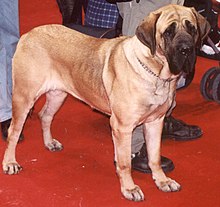Molosser
Molosser is a type of large, solidly-built dog comprising several breeds, probably all descended from the same root stock. The name derives from Molossia,[1] a subregion of ancient Epirus,[2] ancient Greece, where the large shepherd dog was known as the Molossus.[3]
The proper noun "Mastiff", however, is used to refer to the English Mastiff, a breed that originated from Celtic dogs in England over two thousand years ago. Other terms include "Mastín" (Spanish), "Dogge" (Germanic), and "dogue" or "dogo" (Romance languages).

Breeds such as the Bullmastiff, Dogue de Bordeaux, Fila Brasileiro, Pyrenean Mastiff (Mastin Del Pirineo), Spanish Mastiff, Neapolitan Mastiff, Tibetan Mastiff, and many others fall into the larger category of "Molossers", but are not "Mastiffs". Each is a separate and distinct breed.[4] The Boxer breed is also included, as it is a creation from other Molossers including the Old English Bulldog.
Molossers typically have heavy bones, pendant ears, a relatively short and well-muscled neck, and a short muzzle. Although some Molossers are used for search and rescue, such as the Newfoundland and the Saint Bernard, most are used as guard dogs, due to their deep voices and natural guarding instincts, or livestock guardian dogs for protection against large predators as well as poachers. Some breeds like the Greater Swiss Mountain Dog have also been used as cart dogs.
Origins
The first known record of a molosser-type dog was in 1121 BC, when a Tibetan mastiff trained for hunting was given to a Chinese emperor. The mastiffs would later be exported to Mongolia, Mesopotamia and Central Asia where they would mix with local dogs, resulting in a loss of long hair and colour uniformity. The main features, such as height and a massive head with a big short muzzle were kept. The dogs were considered valuable in Babylon, and are mentioned in cuneiform in the 4th century BC. A large mastiff-like dog is shown on the ancient terra cotta by Birs Nimrud. The dog is rather tall: 90 centimetres (35 in) at the withers, has a stocky head and powerful hind quarters. The dogs were used for hunting in ancient Assyria. Archeological digs of the Ashurbanipal palace (7th century BC) revealed pictures of dogs felling wild horses and donkeys. Assyrian mastiffs were also used for military purposes and for protection.
The ancient mastiffs would later be imported from Assyria and Babylon to Egypt and Asia Minor. Xerxes I of Persia led predatory wars to enlarge the borders of his empire, taking with him large war dogs in his Army. After his army's defeat by the Greeks, mastiffs kept as trophies of war. The mastiffs would be bred in Molossia and from there, spread all over the Mediterranean under the name of "epirian" dogs or molosses. Mastiffs were used to fight in the Roman amphitheater against lions and may have been used in lion hunting.
The Alans kept mastiff-like dogs taken from Eastern Europe which acted as retrievers, guard dogs, and fighting dogs. The name associated with these dogs is Alaunt, or in Spanish Alano. The mastiffs were used in unison with sighthounds to hunt wisent, aurochs and bear. Groups of Alanian tribes came to Europe during the Migration Period, fighting on the territory of modern France, Spain, Portugal and Northern Africa, taking with them their dogs. The Alanian mastiffs then spread to the British Isles.[5] The mastiff of the Alps, the Alpine Mastiff, was a progenitor of the St. Bernard and contributed to the modern English Mastiff.
The Bulldog breeds split from the Molossers in England and spread to the New World with colonization as well as Western Europe and, though smaller, are considered by some still to be Molosser breeds.

List of breeds
See also
References
- ^ Dogue De Bordeaux: A Comprehensive Owner's Guide by Joseph Janish,ISBN 1593782152,2003,Page 10,"... THE DOGUE DE BORDEAUX The Dogue de Bordeaux falls into a group of dogs classified as molossers, descendants of the Molossus, a dog that lived around the time of 700 BC. Based on ancient carvings and paintings, it appears that Molossus ..."
- ^ The Mini-Atlas of Dog Breeds by Andrew De Prisco,ISBN 0866220917,1990,page 136,"... Mastiff prototypes , such as the Molossus of Epirus and Babylonian Mastiff, were used as flock guards against wolves and other predators. ..."
- ^ The Mammals of the Southern African Sub-region by J. D. Skinner,ISBN 0521844185,2006,page 277, "... XXII. F<u11ily MOLOSSIDAE Gervais, 1856 Free-tailed bats The name of the family is derived from the Greek molossus, a kind of dog used by Greek shepherds in ancient times. The head of a molossid is reminiscent of a ..."
- ^ [1]
- ^ Volkodav info-Aboriginal dogs of the Caucasus and Asia
